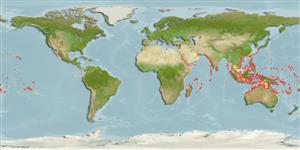Environment: milieu / climate zone / depth range / distribution range
Ecología
marino asociado a arrecife; rango de profundidad 3 - 120 m (Ref. 11890), usually 3 - 20 m (Ref. 90102). Tropical; 30°N - 28°S
Indo-Pacific: Red Sea to the Line and Mangaréva islands, north to Ryukyu Islands, south to southern Great Barrier Reef and Austral Islands.
Tamaño / Peso / Age
Maturity: Lm ? range ? - ? cm
Max length : 12.0 cm TL macho / no sexado; (Ref. 11441)
Espinas dorsales (total) : 8; Radios blandos dorsales (total) : 9; Espinas anales: 2; Radios blandos anales: 8. Distinguished by having the following characteristics: dorsal fin rays VII-I, 9; anal fin rays II, 8; pectoral fin rays 14; pelvic-fin rays I, 5; pored lateral line scales 23; total gill rakers 16-17, developed gill rakers 10-12; circumpeduncular scales 12; predorsal scales 4; body depth 3.0-3.4 in SL (Ref. 93839). Basicaudal spot is centered slightly above the level of the lateral stripe (Ref. 37816). Further characterized by pinkish to pale grey body color; narrow, tapering midlateral stripe; caudal fin base with dark spot that barely touches lateral line on its lower edge (Ref. 90102).
Found under ledges or among isolated coral heads in silty inner reef areas (Ref. 1602). Solitary and rather rare (Ref. 559). Nocturnal species (Ref. 7300). Often found at base of coral outcrops or under ledges (Ref 90102). Feeds on fishes and invertebrates (Ref. 89972). Maximum depth reported taken from Ref. 128797.
Life cycle and mating behavior
Madurez | Reproducción | Puesta | Huevos | Fecundidad | Larva
Mouthbrooders (Ref. 240). Distinct pairing during courtship and spawning (Ref. 205).
Myers, R.F., 1991. Micronesian reef fishes. Second Ed. Coral Graphics, Barrigada, Guam. 298 p. (Ref. 1602)
IUCN Red List Status (Ref. 130435: Version 2024-2)
Threat to humans
Harmless
Human uses
Herramientas
Special reports
Download XML
Fuentes de Internet
Estimates based on models
Preferred temperature (Ref.
123201): 25.3 - 29, mean 27.8 °C (based on 786 cells).
Phylogenetic diversity index (Ref.
82804): PD
50 = 0.5312 [Uniqueness, from 0.5 = low to 2.0 = high].
Bayesian length-weight: a=0.01072 (0.00667 - 0.01721), b=3.04 (2.91 - 3.17), in cm total length, based on LWR estimates for this species & (Sub)family-body (Ref.
93245).
Nivel trófico (Ref.
69278): 3.7 ±0.60 se; based on food items.
Resiliencia (Ref.
120179): Alto, población duplicada en un tiempo mínimo inferior a 15 meses (Preliminary K or Fecundity.).
Fishing Vulnerability (Ref.
59153): Low vulnerability (10 of 100).
Nutrients (Ref.
124155): Calcium = 140 [75, 233] mg/100g; Iron = 0.87 [0.51, 1.45] mg/100g; Protein = 18.6 [17.5, 19.7] %; Omega3 = 0.108 [0.063, 0.193] g/100g; Selenium = 33.6 [16.0, 70.1] μg/100g; VitaminA = 87.9 [29.8, 254.8] μg/100g; Zinc = 1.8 [1.2, 2.6] mg/100g (wet weight);
